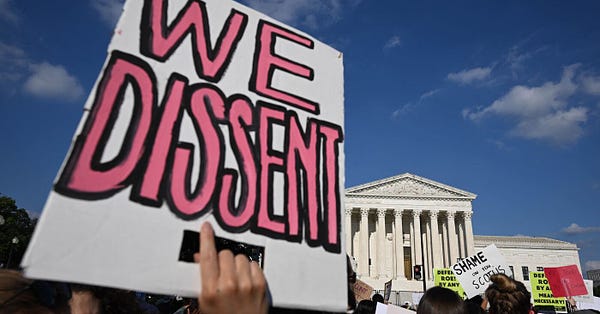Can the Democrats win the Midterms?
Will historical trends hold and Republicans do well? Or will this time be different?
Let’s start with all the caveats. It’s one poll. Polls can be outliers. Public sentiment can shift. We will need to see a lot more evidence. But all that being said, for beleaguered Democratic voters still reeling from the Supreme Court's evisceration of the constitutional right to an abortion — and a host of other issues, from guns to the assault on our democracy — there is at least a little reason for hope.


According to the latest findings of the highly respected NPR/PBS NewsHour/Marist National Poll, Americans overwhelmingly disapprove of the court’s ruling (56-40%). This tracks with what we have seen about polling on abortion in recent years. Taking away this right is highly unpopular. But the question that has always lingered is whether this would be a galvanizing issue for Democratic voters. Well according to this poll, the answer is a resounding yes. But that doesn’t actually make it so.
NPR summarizes the results as a jolt of enthusiasm for Democrats:
“This issue presents volatility into the 2022 midterms, because 78% of Democrats say the court's decision makes them more likely to vote this fall, 24 points higher than Republicans.”
And there has been a significant shift in which party people say they will vote for for Congress in 2022:
“Democrats have regained the favor of voters to control Congress, with 48% saying they are more likely to vote for a Democratic candidate in the fall and 41% more likely to vote for a Republican. In April, Republicans led on that question in the poll 47% to 44%, which was within the margin of error.”
But NPR's writeup of these results does include this important note:
“The lead for Democrats may not translate into maintaining control due to the way voters are geographically distributed and how boundaries of congressional districts are drawn.”
This last caution is important. We live in a federal system, so even large swings of voters, if they occur mainly in states that already are red or blue, might not swing the ultimate composition of Congress. Furthermore, those who analyze partisan leanings in congressional districts say that the latest round of redistricting has led to a far smaller pool of swing districts. This means that much of the Democratic/Republican divide is already gerrymandered in place. Wave elections in either direction become all the more difficult.
We have noted many times before on Steady the historic headwinds that Democrats face in the elections this fall. This starts with the structural precedent of American politics that the party that controls the White House almost always loses seats in Congress in midterms. Then there is President Biden’s low opinion ranking, high inflation (particularly at the pump), the lingering pandemic, and more. There is also the reality that Democratic voters are often less motivated to vote in non-presidential years.
These are especially uncertain times, and uncertainty and anxiety often rebound against those currently in power. The Democrats, with control of both houses of Congress and the White House, are in power.
I know that the Steady readership has a lot of political sophistication. You understand the broader context around the realities of this power. You know that these congressional majorities are razor thin, especially in the Senate where Joe Manchin and Kyrsten Sinema have proven unwilling to abolish the filibuster to allow for up-and-down votes on key Democratic priorities. Furthermore, the legislative and executive branches of government are only 2/3 of the whole. The past few weeks, much of our attention has been driven by the third branch, over which Democrats clearly have no power — the Supreme Court.
If the Democrats are to make a case to voters that, while in power, they are not really in full power, they need to have a clear and deliberate message that anticipates the frustration from the electorate over what is seen as inaction on a host of important issues. You can’t keep saying “vote for us” and then not be seen as delivering.
The journalist Brian Beutler outlined this conundrum in a newsletter back in December anticipating the end of Roe.
“If Roe falls, and Democrats respond in essence by saying “elect more Democrats,” they’re going to get a resounding earful from people who expect them to use their power now, while they have it. I hope that backlash prevails on them, but one way around it would be to level with people: We will fix this by doing X, but we can’t do X until we have Y more Democrats than we currently have. That approach would have the virtue of allowing voters to hold them to a promise. But it’d also require them to specify X and Y, and I think they’re in denial about both.”
Well, in recent days that is exactly what has happened. In an op-ed in The New York Times, Senators Elizabeth Warren and Tina Smith started filling in the X’s and Y’s of Beutler’s equation:
“If voters help us maintain our control of the House and expand our majority in the Senate by at least two votes this November, we can make Roe the law all across the country as soon as January.”
This was echoed by David Plouffe, Barack Obama’s campaign manager in 2008:
House Speaker Nancy Pelosi had the same equation in mind while speaking at a press conference last Friday:
“There is a plan, and that plan is to win the election – hopefully to get two more senators so that we can change the obstacles to passing laws for the good of our country.”
And as if on cue, just as we were wrapping up this post, Hawaii’s Senator Brian Schatz tweeted out this language:
You don’t have to squint hard to see a campaign message emerge: “If you want to save legal abortion in America, you need to vote for Democrats to give enough of a majority in Congress to exert real change.” It is not the easiest sell, and it requires a bit of nuance, but it is likely the Democrats’ best chance.
Of course, evidence of Republican extremism, as we’ve noted here many times, goes far beyond Roe. We can see it on guns, voting rights, and championing the Big Lie. There are real concerns about the separation of church and state and the ability to confront our climate crises.
The shift in voter preference noted in the poll that began this Steady post is undoubtedly due in part to the Roe decision. But it also might be the expanding congressional investigation into the insurrection of January 6. Or it is the frustration over gun deaths, even with the recent legislation, which many Democrats and others didn’t feel went far enough.
Let’s be clear, the Republicans have a lot of strengths in the upcoming elections. But what Roe and other developments do is create more unknowns. They greatly expand the spectrum of the possible. They churn expectations around voter enthusiasm and turnout. Will historical trends hold and Republicans do well? Or will this time be different? Considering how divergent our next two years — and likely the decades to come — would be with the different outcomes, the question over what might happen is really a question over two very different futures for our nation.
Ultimately this will be decided by tens of millions of voters at the polls. With that in mind, I am, as always, very curious about what you think of the current state of the midterms. And, have your views changed in the wake of the abortion decision, the January 6 hearings, or other recent developments?






I always heard people get more conservative as they age. Well, for me and several of my closest friends, nothing could be less true! Stuck in a red state with extreme gerrymandering, a lot of us are “hot as hell and not going to take it anymore.” We also have money—our money—we’re professionals, we’re smart, and we’ve raised smart, successful adults who vote and relocate when the RED is too deep and extreme. I remain hopeful!
I think this time is different, but I'm not sure it's different enough or that Democrats have a strategy to overcome our collective inertia.
We've known for a long time that Republicans don't play fair, while Democrats don't know how to play dirty. Republicans have turned projection, obfuscation, and misdirection into artforms. Democrats have turned their own progressivism vs. moderatism into political quicksand.
The work of the J6 committee may be succeeding in exposing what really happened, and in so doing, cleaving some honorable Republicans from the real RINOs (e.g., Trump, McCarthy, Ron Johnson, Jim Jordan, Cruz, Gaetz, MTG). We need to offer the honorables some noseworthy alternatives.
We also need to stay angry at the right things. Nothing that took months or years to develop can be fixed overnight. Fixing complex problems means that there will be unintended consequences and mistakes will be made. We have to be patient and tune out the constant refrain of failure. We have to realize that it's much harder to build than it is to destroy, and what's been built in the past two years on the rubble of the previous four is pretty amazing, given the thin majorities and the Republican obstructionism.
We need to be motivated by that anger, to vote ourselves, and encourage others to vote as well. We need to win overwhelmingly, and restore some sanity so we can save our democracy.
We need to communicate, individually and collectively. And we need our leaders and candidates to change their messaging to instead talk about the issues and stop asking for money. And if they want to do surveys, they need to allow responses without having to donate money. They should be out leading rallies, bringing attention to the issues and offering viable solutions.
p.s. There's a lot to unpack here. Sorry for the stream of consciousness dump, but my anger and motivation is building by the day. Also, it's kinda hard to write a cogent response on an iphone.